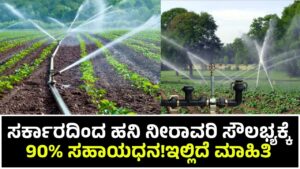Pipe : Applications Invited from Farmers for Free Pipe and Sprinkler Subsidy Scheme
Introduction
In the face of unpredictable monsoons and depleting groundwater levels, efficient water management has become paramount for Indian agriculture. The Government of India, in collaboration with state governments, has introduced various subsidy schemes to promote water-use efficiency among farmers. These initiatives aim to provide financial assistance for the installation of micro-irrigation systems, such as drip and sprinkler irrigation, and for the procurement of water-carrying pipes. This essay delves into the details of these schemes, their implementation, and their impact on the agricultural landscape.

1. Overview of Micro-Irrigation Subsidy Schemes
1.1 Pradhan Mantri Krishi Sinchayee Yojana (PMKSY) – Per Drop More Crop
Launched in 2015, PMKSY aims to enhance water-use efficiency in agriculture through the adoption of micro-irrigation techniques. Under the ‘Per Drop More Crop’ component, farmers are provided subsidies for installing drip and sprinkler irrigation systems. The subsidy rates vary based on the farmer’s category and the type of crop cultivated.
Eligibility Criteria
- Land Ownership: Farmers must own cultivable land.
- Crop Type: Preference is given to horticultural and high-value crops.
- Farmer Category: Subsidy rates differ for small and marginal farmers, general farmers, and SC/ST farmers.
Subsidy Details
- Small and Marginal Farmers: Up to 75% subsidy.
- Other Farmers: Up to 55% subsidy.
- Maximum Subsidy: ₹93,750 per hectare.
Application Process
- Registration: Farmers must register on the official PMKSY portal.
- Documentation: Submission of land records, Aadhaar card, and bank details.
- Approval: On-site inspection by agriculture officers.
1.2 State-Specific Schemes
In addition to PMKSY, several states have introduced their own micro-irrigation subsidy schemes to cater to regional needs.
Karnataka
- Scheme: Micro-Irrigation Subsidy Scheme.
- Subsidy: Up to 75% for small and marginal farmers; 50% for others.
- Application: Online registration through the Karnataka State Agriculture Department portal.
Maharashtra
- Scheme: Micro-Irrigation Scheme under the National Mission on Micro Irrigation.
- Subsidy: 55% for small and marginal farmers; 45% for others.
- Application: Submission through the Maharashtra State Agriculture Department.
Telangana
- Scheme: Micro-Irrigation Scheme for SC/ST and BC farmers.
- Subsidy: 100% for SC/ST farmers; 90% for BC farmers; 80% for others.
- Application: Through the Telangana State Horticulture Department.
Tamil Nadu
- Scheme: Micro-Irrigation Scheme under the National Mission on Micro Irrigation.
- Subsidy: 50% for small and marginal farmers; 40% for others.
- Application: Online registration via the Tamil Nadu Agricultural Department portal.
2. Water-Carrying Pipe Subsidy Scheme
2.1 Objective
To facilitate the transportation of water from sources to fields, the government offers subsidies for the purchase of water-carrying pipes. This initiative aims to reduce water wastage and ensure equitable distribution across agricultural lands.
2.2 Eligibility Criteria
- Land Ownership: Farmers must own cultivable land.
- Distance: Pipes should cover a distance of up to 800 meters.
- Material: Eligible materials include PVC, HDPE, and other approved types.
2.3 Subsidy Details
- Subsidy Rate: 50% of the cost or ₹15,000, whichever is lower.
- Maximum Length: Up to 800 meters.
2.4 Application Process
- Registration: Farmers need to register through the respective state’s agriculture department portal.
- Documentation: Submission of land records, Aadhaar card, and bank details.
- Approval: On-site inspection by agriculture officers.
3. Impact of Subsidy Schemes on Agriculture
3.1 Increased Water Use Efficiency
The adoption of micro-irrigation systems has led to significant improvements in water use efficiency. Drip irrigation, for instance, delivers water directly to the plant roots, minimizing evaporation and runoff.
3.2 Enhanced Crop Yield
With precise water application, crops receive optimal hydration, leading to increased yields. This is particularly beneficial for high-value crops that require consistent water supply.
3.3 Reduced Labor Costs
Automated irrigation systems reduce the need for manual labor, leading to cost savings for farmers. This is especially advantageous during peak agricultural seasons.
3.4 Environmental Benefits
Efficient water use reduces the strain on water resources, contributing to environmental conservation. Additionally, the reduction in water wastage helps in maintaining the ecological balance.
4. Challenges in Implementation
4.1 Awareness and Training
Many farmers, especially in rural areas, lack awareness about the benefits and operation of micro-irrigation systems. Training programs are essential to bridge this knowledge gap.
4.2 Financial Constraints
Despite subsidies, the initial investment for installing micro-irrigation systems can be substantial. Financial assistance and easy access to credit can alleviate this barrier.
4.3 Maintenance and Technical Support
Regular maintenance and technical support are crucial for the longevity of irrigation systems. Establishing local service centers can ensure timely repairs and maintenance.
5. Recommendations for Improvement
5.1 Awareness Campaigns
Government and non-governmental organizations should conduct awareness campaigns to educate farmers about the benefits and operation of micro-irrigation systems.
5.2 Financial Support
Providing easy access to credit and financial assistance can help farmers overcome the initial investment barrier.
5.3 Strengthening Support Systems
Establishing local service centers for maintenance and technical support can ensure the longevity and efficiency of irrigation systems.
6. Conclusion
The “Applications Invited from Farmers for Free Pipe and Sprinkler Subsidy Scheme” is a commendable initiative by the government to promote efficient water use in agriculture. While the schemes have shown positive impacts, addressing the challenges in implementation can further enhance their effectiveness. With continued support and awareness, these initiatives can pave the way for sustainable agricultural practices in India.
